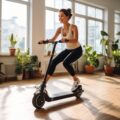Introduction to Quick Full-Body Workouts
Welcome to our compassionate guide on quick full-body workouts! In our busy lives, it’s easy to feel overwhelmed and neglect our physical wellbeing. This article aims to empower you with a gentle, holistic approach to fitness that nurtures both body and mind. We’ll explore how brief, mindful exercise sessions can boost your overall wellness and help you feel more connected to yourself.
The Benefits of Full-Body Workouts
Full-body workouts offer a wealth of benefits that extend far beyond physical fitness. They can:
- Boost your mood and energy levels
- Reduce stress and anxiety
- Improve sleep quality
- Enhance body awareness and mindfulness
- Increase overall strength and flexibility
- Save time while providing comprehensive exercise
Remember, the goal isn’t to push yourself to exhaustion, but to move in ways that feel good and bring joy to your day.
Creating a Balanced Full-Body Routine
A well-rounded full-body workout should gently engage all major muscle groups. Here’s a simple structure to follow:
- Warm-up (5 minutes): Start with gentle movements like arm circles, leg swings, and light jogging in place to prepare your body.
- Upper body (5-7 minutes): Include exercises like modified push-ups, arm circles, or gentle overhead presses.
- Lower body (5-7 minutes): Try bodyweight squats, lunges, or step-ups at a comfortable pace.
- Core work (5 minutes): Engage your midsection with planks, gentle crunches, or seated twists.
- Cooldown and stretch (5 minutes): Finish with deep breaths and gentle stretches to promote relaxation.
Listen to your body and modify any movements as needed. The key is consistency and self-compassion, not intensity.
Mindful Movement Techniques
Incorporating mindfulness into your workout can transform it from a purely physical activity into a holistic wellness practice. Try these techniques:
- Breath awareness: Focus on your breath as you move, using it as an anchor for your attention.
- Body scanning: Regularly check in with different parts of your body, noticing sensations without judgment.
- Gratitude practice: As you exercise, mentally list things you’re grateful for, including your body’s abilities.
- Intention setting: Begin your workout by setting a positive intention, such as “I move to nurture my wellbeing.”
These practices can help you stay present and cultivate a deeper connection with your body.
Adapting Your Workout to Your Needs
Every body is unique, and it’s essential to honor your individual needs and limitations. Here are some tips for adapting your workout:
- If you have limited mobility, try seated or reclined versions of exercises.
- On low-energy days, focus on gentle stretching or yoga-inspired movements.
- If you’re short on time, even a 5-10 minute session can be beneficial.
- Experiment with different times of day to find when you feel most energized.
- Include activities you genuinely enjoy to make exercise a positive experience.
Remember, the most effective workout is one that you’ll do consistently and that makes you feel good.
Incorporating Mindful Recovery
Recovery is just as important as the workout itself. After your session, take a moment to:
- Practice deep, calming breaths
- Gently stretch any areas that feel tight
- Hydrate mindfully, savoring each sip of water
- Reflect on how your body feels and what it might need
- Express gratitude to yourself for taking this time for self-care
These simple practices can help transition you back into your day with a sense of calm and accomplishment.
Frequently Asked Questions
1. How often should I do a full-body workout?
Listen to your body, but aim for 2-3 times a week if possible. Remember, consistency is more important than frequency. Even once a week can be beneficial if that’s what fits your life right now.
2. Do I need equipment for a full-body workout?
Not at all! Bodyweight exercises can provide a complete workout. If you enjoy using equipment and have access to it, that’s great too. The most important thing is to move in ways that feel good to you.
3. How long should a quick full-body workout last?
A quick full-body workout can be effective in as little as 15-20 minutes. The duration matters less than the quality of movement and your mindful engagement with the exercise.
4. Can full-body workouts help with stress relief?
Absolutely! Physical activity releases endorphins, which can improve mood and reduce stress. Combining movement with mindfulness techniques can be especially powerful for stress relief.
5. Is it normal to feel sore after a full-body workout?
Some muscle soreness can be normal, especially if you’re new to exercise or trying new movements. However, pain should never be the goal. If you experience persistent pain, it’s important to rest and consult a healthcare professional if needed.
Remember, the journey to wellness is personal and unique. Be patient with yourself, celebrate small victories, and always prioritize self-compassion in your fitness journey. Your body is amazing just as it is, and any movement you do is a gift to yourself. Here’s to nurturing your wellbeing, one mindful workout at a time!









